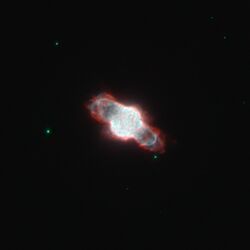Astronomy:NGC 6886
From HandWiki
Short description: Planetary nebula in the constellation Sagitta
| Emission nebula | |
|---|---|
| Planetary nebula | |
 An HST picture of nebula NGC 6886. Credit: ESA/Hubble | |
| Observation data: J2000 epoch | |
| Right ascension | 20h 12m 42.83s[1] |
| Declination | +19° 59′ 22.6″[1] |
| Distance | 4.6 ± 1.0 kiloparsec (15.0 ± 3.3 kly) ly |
| Apparent magnitude (V) | 11.8[1] |
| Constellation | Sagitta |
| Designations | PK 060.1-07.7,[2] Hen 2-458[1] |
NGC 6886 is a planetary nebula in the constellation Sagitta. It was discovered by Ralph Copeland on September 17, 1884.[3] It is 4.6 ± 1.0 kiloparsec (15.0 ± 3.3 kly) distant from Earth, and is composed of a hot central post-AGB star that has 55% of the Sun's mass yet 2700 ± 850 its luminosity, with a surface temperature of 142,000 K. The planetary nebula is thought to have been expanding for between 1280 and 1600 years.[4]
References
- ↑ 1.0 1.1 1.2 1.3 "NGC 6886". SIMBAD. Centre de données astronomiques de Strasbourg. http://simbad.u-strasbg.fr/simbad/sim-basic?Ident=NGC+6886.
- ↑ Pottasch, S. R.; Surendiranath, R. (March 2005). "Abundances in planetary nebulae: NGC 6886". Astronomy and Astrophysics 432 (1): 139–148. doi:10.1051/0004-6361:20042006. Bibcode: 2005A&A...432..139P.
- ↑ Seligman, Courtney. "NGC Objects: NGC 6850 - 6899". http://cseligman.com/text/atlas/ngc68a.htm.
- ↑ Schönberner, D.; Balick, B.; Jacob, R. (2018). "Expansion patterns and parallaxes for planetary nebulae". Astronomy & Astrophysics 609: A126. doi:10.1051/0004-6361/201731788. Bibcode: 2018A&A...609A.126S.
External links
Coordinates: ![]() 20h 12m 42.83s, 19° 59′ 22.6″
20h 12m 42.83s, 19° 59′ 22.6″
 |

